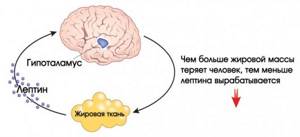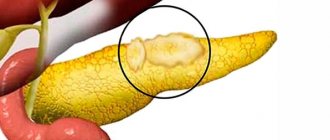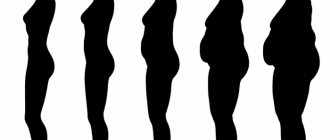A person’s health is largely determined by his hormonal levels. The cause of many health problems often lies in hormonal imbalances, since hormones regulate almost all physiological processes, including burning fat in your body. We describe in detail how and what hormones affect body weight in our next useful article.
canva.com
Why can't I lose weight?
Do you follow a healthy diet, but still can’t normalize your weight? Do you think that your struggle with excess weight is a story without end? If you, like many others, lead a fairly active lifestyle and eat healthy, the culprit for your excess weight is a hormonal imbalance.
Fortunately, this problem, while still requiring diagnosis and accurate diagnosis, is not as difficult to solve as you might think. Next, we will talk about 6 hormones, the levels of which must be normalized in order to accelerate weight loss.
Reducing insulin resistance (insensitivity)
Insulin is a hormone that controls blood glucose levels. Glucose is formed as a result of the breakdown of food during digestion. It is an important source of energy or fat reserves.
Insulin prevents glucose from building up in the blood. To do this, he sends it to the blood cells. With insulin resistance, cells are unable to use insulin to get it inside the cells. Consequently, blood glucose levels increase.
To somehow compensate for this, the body begins to produce more and more insulin, which ultimately leads to diabetes, since glucose is not absorbed properly by the body. When there is excess glucose in the blood, the body stores it, first in the form of glycogen.
If there is too much of it, glycogen is transformed into fats. A prolonged increase in insulin leads to excess weight gain. Over time, obesity may occur. Another problem associated with insulin resistance is polycystic ovary syndrome.
How to reduce insulin resistance
Here are some basic tips to help prevent or reduce insulin resistance:
- Eat a low-carbohydrate diet to avoid elevated blood glucose levels.
- Include foods such as avocados, pomegranates, berries, various types of peppers, lean proteins, and high-fiber whole grains in your diet.
- Exercise should also be part of your daily routine. Moderate and regular physical activity helps normalize insulin levels. Even a daily half-hour walk reduces the risk of developing diabetes by 30%.
Consequences of obesity
For a long time, excess weight was viewed as primarily a cosmetic defect. It was then discovered that adipose tissue is hormonally active. Proven properties are:
- independent production of a number of hormones (leptin, resistin, adiponectin);
- changes in the metabolism of fats and carbohydrates;
- regulation of hormonal synthesis at the level of the pituitary gland, hypothalamus, adrenal glands and ovaries.

This explains why obesity:
- causes infertility;
- increases the risk of tumors of the mammary glands, uterus and ovaries;
- provokes the development of type 2 diabetes, angina pectoris, hypertension, digestive diseases, polycystic ovary syndrome;
- reduces life expectancy by an average of 10 years.
Reducing cortisol levels prevents stress eating
Cortisol is a stress hormone that regulates our response to stressful situations. Unfortunately, with frequent stress due to lack of sleep, problems at work and in your personal life, and even poor diet (for example, abuse of caffeinated drinks), there is a high probability of a sharp rise in cortisol levels, which can become persistent.
In a situation of stress, as a rule, our craving for sweets increases in order to somehow alleviate our condition. And this is the right path to gaining extra pounds. Additionally, if you don't sleep well, high cortisol levels can contribute to the development of insulin resistance, which is also a factor in obesity.
How to Reduce Cortisol Levels
- Sleep at least 7 hours at night. To improve sleep, eat foods containing tryptophan and melatonin, namely cottage cheese, turkey, kiwi, and cherries. At least 2 hours before bedtime, avoid drinking caffeinated drinks or using electronic devices with bright screens.
- Daily physical activity helps the body adapt to increased levels of cortisol and the production of endorphins, hormones that improve mood, i.e. their action is opposite to that of cortisol.
- Yoga and other types of physical activity aimed at relieving stress and tension.
Principles of treatment
Based on the obtained diagnostic data, a plan for correcting the pathological condition is developed.
If obesity occurs due to hormonal imbalance, an integrated approach is provided, the essence of which is:
- Following a diet. The list of products is compiled taking into account which hormone deficiency or excess caused obesity. For example, excess testosterone production requires limiting protein intake, and in case of endocrine disorders, it is necessary to reduce sugar intake.
- Reviewing the daily routine and normalizing physical activity.
- Taking medications that will help regulate the secretion of hormones. It is also possible to replace the medication or abandon it if it provokes hormonal imbalances.
In severe cases, the patient is prepared for surgery. In addition, therapy may include visiting a therapist.
Normalizing estrogen levels prevents fat accumulation
Estrogens, better known as female sex hormones, play an important role in weight control. When hormone levels are balanced, insulin levels normalize. This in turn ensures normal levels of glucose in the blood, which serves as a source of energy for the muscles. However, estrogen imbalance is a significant risk factor for excess weight.
The reason for the increased level of estrogen may be associated with dietary patterns, which are dominated by meat products. A decrease in estrogen levels is possible with polycystic ovary syndrome and obesity.
Low estrogen levels increase the likelihood of developing insulin resistance, which reduces the amount of glucose that serves as fuel for muscles and therefore increases its levels in the blood. The body begins to store it in the form of fat, and our waistline grows.
How to regulate estrogen levels
- If estrogen levels are low, eat more fresh fruits, vegetables (except cruciferous vegetables), whole grains, and fish. It is also necessary to reduce the consumption of caffeinated drinks.
- If your estrogen levels are high, include cruciferous vegetables such as broccoli and cabbage in your diet. It is better to steam or stew them.
Controlling leptin levels – preventing overeating
Our appetite is controlled by 2 hormones, one of them is leptin. It regulates the energy balance in the body, and in a broader sense, appetite. In some cases, our body develops leptin insensitivity. As a result, you eat more than you need because you don't feel full while eating.
If you eat a diet high in sugar, processed foods, drink too much alcohol, or get too little sleep, your leptin levels may peak. For rapid weight loss, it is important to control leptin levels.
How to control leptin levels
- Avoid eating processed foods and sugary snacks.
- Avoid alcohol.
- Choose vegetables over fruits, especially those high in fructose.
Supporting optimal testosterone levels – a factor in intense fat burning
The male sex hormone significantly affects metabolic processes in both men and women. Its deficiency can cause fat accumulation in the body and a decrease in muscle mass, which in turn leads to a decrease in metabolic rate and the body's ability to burn fats and carbohydrates.
In addition, a lack of testosterone increases cholesterol and triglyceride levels in the blood, and reduces insulin sensitivity. The result is excess weight and fat accumulation.
How to increase testosterone levels
- Reduce the amount of foods with phytoestrogens in your diet, such as soy, which reduces testosterone levels.
- Limit your consumption of bread, alcohol, and sugary drinks.
- Avoid drinking water from plastic bottles made with BPA.
Examination of women
If external signs of hormonal obesity and typical symptoms are detected, the endocrinologist recommends the following diagnostic methods:
- blood test for hormones: pituitary gland (follitropin, somatostatin, lutropin, prolactin, corticotropin, thyrotropin), adrenal glands (cortisol, dehydroepiandrosterone), thyroid gland (thyroxine), reproductive (testosterone, estradiol, progesterone), adipose tissue (leptin, adiponectin);
- blood sugar and glucose tolerance test, according to indications - insulin and C-peptide;
- lipid profile (cholesterol, lipoprotein ratio, triglycerides);
- Ultrasound of the adrenal glands, thyroid gland, ovaries, pancreas;
- MRI or CT scan of the pituitary-hypothalamic zone of the brain.

Ultrasound of the adrenal glands
Activation of the thyroid gland improves metabolic processes
Thyroid hormones T3 and T4 play a significant role in regulating body weight. These hormones determine the speed of metabolic processes in the body. With hypothyroidism, which is characterized by insufficient activity of the thyroid gland and, as a result, a deficiency of its hormones, metabolic processes slow down and weight rapidly increases.
Also, if there is a lack of hormones, complaints of fatigue, apathy, decreased performance, and mood swings immediately appear. Lack of energy makes it difficult for a person to perform physical work and be physically active.
One cannot fail to mention the relationship between the work of the thyroid gland and the digestive system. The intestinal immune system controls the production of thyroid hormones. A sluggish thyroid gland causes sluggish digestion.
This in turn increases pathogenic microflora in the intestines and reduces the amount of certain enzymes, including intestinal sulfatase, which is necessary to convert the T4 hormone into the T3 hormone, which results in weak thyroid function. Thus, we see that a vicious circle arises. Its rupture is vital to human health.
How to treat hypothyroidism
- Reduce your intake of soy, iodine, caffeine and refined carbohydrates. Eat more protein foods. Eliminate foods containing gluten. Do not eat goitrogenic foods (cabbage, broccoli, cauliflower, spinach, kale) raw. Heat treatment and fermentation of these vegetables reduces their goitrogenic effect, which suppresses the production of thyroid hormones.
- Do not deny yourself the opportunity to stay in the sun, but only carefully, at the right time.
- Learn stress-relieving techniques, as thyroid problems are closely related to stress. Stress is the main enemy of the thyroid gland.
- Avoid intense workouts. Playing sports should bring you pleasure and benefit your body. Nordic walking, yoga, hiking are the most suitable types of physical activity for hypothyroidism.
SEE ALSO: Hormonal balance in women: 5 of the most beneficial herbs and plants to curb female hormones
The main conclusion: for our body to work smoothly as one whole, we need a healthy hormonal system. The hormonal system coordinates the work of all human organs and tissues. For the proper functioning of the hormonal system, it is important to eat a healthy diet, give up bad habits, regular moderate physical activity, the ability to curb stress, avoid sudden spikes in insulin, not skimp on sleep, and also visit an endocrinologist from time to time. Self-regulation of hormones without consulting a doctor is unacceptable!
From: curejoy.com
Comment
Diet for hormonal imbalance
The diet should not be too low in calories. This leads to even more weight gain. A balanced diet during hormonal imbalance in women helps to lose weight. This can be a metabolic or selenium-zinc diet. The last two are aimed at accelerating metabolism and replenishing the lack of certain microelements. Each hormonal diet for weight loss has a number of rules, a list of prohibited and recommended foods.
Products
If it is difficult to follow a specific diet, then you can simply eat only permitted and conditionally prohibited foods. In addition to them, hormonal nutrition also has a list of foods that need to be completely excluded from the diet. Conditionally prohibited foods include those foods that are recommended to be sharply limited in order to lose weight. Their list includes:
- potato;
- condensed milk;
- sweet packaged juices;
- canned food in oil;
- soft carbonated drinks;
- sausage;
- salo;
- milk and fermented milk products with high fat content;
- White bread;
- mayonnaise.
- Almonds - benefits and harm for women and men
- How to cook khinkali correctly. Cooking recipes and how many minutes to cook khinkali in water and steam
- How to cook fish soup
These types of foods contribute to the storage of fat in reserve, especially when consumed in large quantities. They can be consumed in a reasonable amount 1-2 times every 2 weeks, but not more often. To make it more convenient to think through the menu, it is recommended to use the following summary table of permitted and prohibited products:
| Product category | Names | Carbohydrates, g | Fats, g | Proteins, g | Calories, kcal |
| Allowed | |||||
| Vegetables and greens | Cabbage | 4,7 | 0,1 | 1,8 | 27 |
| Zucchini | 4,6 | 0,3 | 0,6 | 24 | |
| Tomatoes | 4,2 | 0,2 | 0,6 | 20 | |
| Pumpkin | 7,7 | 0,3 | 1,3 | 28 | |
| cucumbers | 2,8 | 0,1 | 0,8 | 15 | |
| Radish | 3,4 | 0,1 | 1,2 | 19 | |
| Fruits | Apples | 9,8 | 0,1 | 0,4 | 47 |
| Peaches | 11,3 | 0,1 | 0,9 | 46 | |
| Watermelon | 5,8 | 0,1 | 0,6 | 25 | |
| Nectarine | 11,8 | 0,2 | 0,9 | 48 | |
| Plums | 9,6 | 0,3 | 0,8 | 42 | |
| Cereals | Buckwheat | 62,1 | 3,3 | 12,6 | 313 |
| Oatmeal | 59,5 | 6,1 | 12,3 | 342 | |
| Rice cereal | 72,9 | 1,8 | 7,4 | 337 | |
| Low-fat dairy products | Kefir | 4,7 | 2,0 | 3,4 | 31 |
| Milk | 4,8 | 3,6 | 3,2 | 64 | |
| Acidophilus | 3,8 | 3,2 | 2,8 | 57 | |
| Sour cream 15% | 3,0 | 15,0 | 2,6 | 158 | |
| Curdled milk | 4,1 | 2,5 | 2,9 | 53 | |
| Meat | Beef | 0,0 | 19,4 | 18,9 | 187 |
| Veal | 0,0 | 1,2 | 19,7 | 90 | |
| Rabbit | 0,0 | 8,0 | 21,0 | 156 | |
| Prohibited | |||||
| Vegetables and greens | Carrot | 6,9 | 0,1 | 1,3 | 32 |
| Beet | 8,8 | 0,1 | 1,5 | 40 | |
| Horseradish | 10,5 | 0,4 | 3,2 | 56 | |
| Fruits | Bananas | 21,8 | 0,2 | 1,5 | 99 |
| Melon | 7,4 | 0,3 | 0,6 | 33 | |
| Pineapples | 10,6 | 0,2 | 0,4 | 49 | |
| Mango | 11,5 | 0,3 | 0,5 | 67 | |
| Grape | 16,8 | 0,2 | 0,6 | 65 | |
| Pasta and flour products | Pasta | 69,7 | 1,1 | 10,4 | 337 |
| Noodles | 60,1 | 3,7 | 12,0 | 322 | |
| Cereals | Semolina | 73,3 | 1,0 | 10,3 | 328 |
| Rice | 69,3 | 3,3 | 6,7 | 344 | |
| Sweets | Candies | 67,5 | 19,8 | 4,3 | 453 |
| Ice cream | 22,1 | 6,9 | 3,7 | 189 | |
| chocolate | 56,5 | 35,3 | 5,4 | 544 | |
Seleno-zinc
In case of insufficient production or absence of sex hormones, a selenium-zinc diet is recommended. It is especially effective at the age of 14-16 years, when menstruation has not yet occurred. This diet for hormonal imbalance in women is based on the consumption of foods containing selenium and zinc. They regulate the secretion of sex hormones. With a lack of zinc and selenium, women's sexual activity decreases and the menstrual cycle is disrupted.
There are no special instructions for the diet. The main condition is to eat food containing these microelements. Zinc is found in the following foods:
- sprouted wheat grains;
- beans;
- squid, mussels, clams and other seafood;
- oysters;
- black currant;
- seaweed;
- blueberry;
- Pine nuts;
- peanuts, almonds;
- oats and oat flakes;
- lentils;
- pumpkin seeds;
- beef;
- animal liver.

Stable excess weight that cannot be lost over a long period of time indicates a selenium deficiency. You can compensate for the deficiency of this microelement by consuming the following products:
- eggs;
- coconuts;
- pistachios;
- basil;
- animal liver;
- corn;
- lentils;
- garlic;
- rice;
- beans;
- salo.
It is recommended to include these products in the daily diet, otherwise the level of selenium and zinc in the body will not normalize. Sample menu options:
| Eating | First menu option | Second menu option |
| Breakfast | 2 boiled eggs, green tea | Oatmeal with milk, tea |
| Snack | Handful of pistachios | Pumpkin seeds, juice |
| Dinner | Beef or lamb steak with lentils | Chicken liver with gravy, rice or buckwheat |
| Afternoon snack | Pine nuts | A handful of blueberries or lingonberries |
| Dinner | Boiled beans with meat | Salad with corn and crab sticks |
Metabolic
In medicine, metabolism refers to the metabolism of substances in the body and their conversion into energy. The higher its speed, the faster a person can lose weight. The body produces fat-burning hormones, such as norepinephrine, testosterone, adrenaline, and fat-saving hormones, including estrogen, insulin. The essence of the metabolic diet is to increase the production of the former and inhibit the secretion of the latter. She divides all products into categories with a certain value from 0 to 4. You can lose weight using this method in 3 stages:
- The first, or active fat burning. Lasts 3 weeks. Involves consuming only zero-value foods with a low glycemic index.
- Second, or stable combustion. The menu for the day should not exceed 9 points: breakfast - 4, second breakfast - 2, lunch - 2, afternoon snack - 1, dinner - 0.
- Third, or consolidation. Gradually, one point is added to each meal. When your body weight is fixed at one level, you can eat according to the resulting scheme constantly.
The longest phase of the diet is the second. It can be observed for as long as desired. It will be difficult to calculate points at first, but judging by the feedback from women, in the future it will even be of interest. Sample menu options for this stage:
| Eating | First menu option | Second menu option |
| Breakfast | Oatmeal with berries, kefir or milk | Milk, cheesecakes |
| Snack | 2 apples | Cheese cheese with vegetables |
| Dinner | Vegetable salad with boiled chicken or turkey | Boiled fish, cucumber, herbs and tomato salad |
| Afternoon snack | Cottage cheese with a handful of berries | A portion of cottage cheese with honey |
| Dinner | Vegetables, scrambled eggs | Vegetables with baked rabbit |











